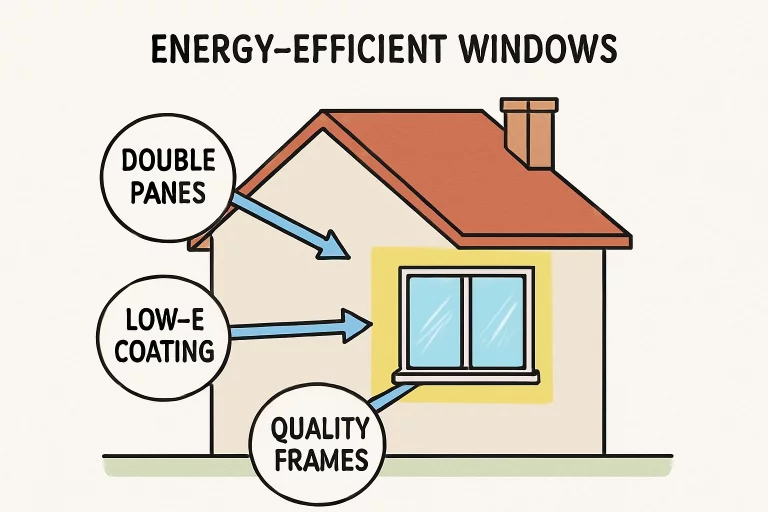Business owners today face increasingly complex security challenges, ranging from petty theft to large-scale organized retail crime.These evolving threats demand more than traditional methods—they require smarter, proactive solutions. Reflecting this shift, the National Retail Federation noted a rise in concern among retailers, with 78.1% identifying organized retail crime as a higher priority in 2023, up from 70.7% in 2022.
As criminal tactics become more advanced, modern surveillance cameras have become a vital part of business security, offering real-time monitoring that helps deter, detect, and document suspicious activity. With technology playing a central role in safeguarding assets, employees, and customers, let’s explore how modern camera systems go far beyond basic recording.
Comprehensive Protection: The Core Benefits of CCTV Camera Systems
Installing a robust CCTV camera system provides multiple layers of protection for your business operations. These systems offer far more than just recording capabilities – they actively contribute to creating a safer environment.
Crime Deterrence and Prevention
The mere presence of visible surveillance cameras significantly reduces the likelihood of criminal activity on your premises. Potential wrongdoers who notice cameras monitoring the area often reconsider their actions, knowing they’re being watched.
Research shows that businesses displaying obvious CCTV camera equipment experience up to 40% fewer break-in attempts compared to similar businesses without visible security measures. Strategic placement of cameras at entrances, cash registers, and inventory storage areas maximizes this deterrent effect.
Modern systems with real-time monitoring capabilities help prevent crimes before they escalate Upon detecting suspicious activity, security personnel can act immediately—investigating or alerting authorities, potentially stopping criminal acts in progress.
Evidence Collection for Legal Protection
High-definition footage provides invaluable evidence should an incident occur at your business. Today’s security camera systems capture clear, detailed recordings that can identify perpetrators and document exactly what happened during an event.
This evidence proves crucial for insurance claims and legal proceedings. Many businesses have successfully used surveillance footage to counter fraudulent liability claims, proving that alleged incidents either didn’t occur or occurred differently than claimed.
The detailed documentation these systems provide also helps streamline investigations by law enforcement. Clear footage can lead to faster case resolution and higher rates of successful prosecution when crimes do occur.
Remote Security Monitoring: Business Protection from Anywhere
Modern business security solutions offer unprecedented accessibility through remote monitoring capabilities. Using secure connections, business owners can access live and recorded footage from anywhere in the world.
24 hour surveillance cameras give continuous protection whether you’re on-site or halfway across the globe. Through mobile applications and web portals, you can check in on your business at any time, ensuring everything is running smoothly even when you’re away.
Remote security monitoring systems send instant notifications when unusual activity is detected. These alerts allow for immediate response to potential security breaches, often through professional monitoring services that can verify threats and dispatch authorities if needed.
As we’ve seen how surveillance systems protect your physical assets, let’s explore how they can provide strategic advantages that go beyond traditional security functions.
Beyond Security: Strategic Business Advantages of Surveillance Systems
Modern surveillance cameras deliver benefits that extend far beyond basic security. These systems can provide valuable insights that help optimize operations and improve customer experiences.
Operational Efficiency Insights
Video surveillance allows business owners to analyze workplace patterns and identify opportunities for improvement. By reviewing footage, you can spot bottlenecks in customer service processes or inefficiencies in employee workflows.
These insights empower managers to make data-driven decisions about staffing levels, scheduling, and resource allocation. For example, footage might reveal that certain times of day require additional staff at registers to prevent long wait times.
Equipment usage monitoring through cameras helps identify maintenance needs before breakdowns occur. This proactive approach reduces downtime and extends the lifespan of valuable business assets.
Customer Behavior Analytics and Business Intelligence
Advanced security camera systems with analytics capabilities can transform raw footage into actionable business insights. Heat mapping features track customer movement patterns to identify high-traffic areas and dead zones within your store.
Understanding how customers interact with displays and products helps optimize store layouts. Retailers can strategically place high-margin items in areas where customers naturally spend more time, potentially increasing sales.
When integrated with point-of-sale systems, video analytics can correlate customer behavior with actual purchases. This connection between observation and transaction data provides deeper insights into what drives buying decisions.
Enhancing Workplace Safety Standards
Surveillance cameras contribute significantly to safer work environments by monitoring compliance with safety protocols. Footage can identify when employees skip required safety procedures, allowing for targeted training interventions.
Video monitoring identifies potential workplace hazards before accidents occur. Regular review of camera footage can reveal unsafe conditions or practices that might otherwise go unnoticed until an incident happens.
In case of workplace accidents, video documentation provides objective evidence of what occurred. This information proves valuable for improving safety training and preventing similar incidents in the future.
The strategic benefits of surveillance extend even further as technology continues to advance. Next, let’s examine the cutting-edge features available in today’s systems.
Advanced Features of Modern Business Security Camera Systems
Today’s security camera systems incorporate sophisticated technologies that make them more powerful and versatile than ever before. These advanced capabilities enhance both security functions and business operations.
AI-Powered Video Analytics
Artificial intelligence has transformed what surveillance cameras can accomplish. Modern systems use AI to distinguish between normal activity and potential threats, dramatically reducing false alarms.
Facial recognition technology can identify authorized personnel and flag unknown individuals in restricted areas. This capability enhances access control and provides an additional layer of business security.
Object-detection algorithms can identify specific items of interest, such as abandoned packages or weapons, alerting security personnel immediately when these items appear in camera views.
Integration with Existing Business Systems
Today’s security camera systems connect seamlessly with other business technologies to create comprehensive protection solutions. When integrated with access control systems, cameras can record who enters specific areas and when.
Alarm system integration enhances response capabilities by automatically focusing cameras on areas where sensors have been triggered. This coordination provides immediate visual verification of potential threats.
POS integration synchronizes transaction data with video footage, making it easy to investigate suspicious purchases or returns. This connection helps identify both customer and employee theft more efficiently.
Scalable Solutions for Growing Businesses
Modern surveillance systems can grow alongside your business. Modular designs allow for adding cameras and expanding coverage areas without replacing existing equipment.
Cloud storage options provide flexible video retention capabilities that can scale up or down based on your needs. This eliminates concerns about running out of storage space as your system expands.
Enterprise-level solutions offer centralized management for businesses with multiple locations. These systems allow security teams to monitor numerous sites from a single interface, streamlining operations.
With a clear understanding of available technology, let’s examine how to implement an effective surveillance strategy for your specific business needs.
Implementing an Effective CCTV Camera Strategy for Your Business
Creating an effective surveillance system requires careful planning and consideration of your specific security needs. A thoughtful approach helps maximize protection while managing costs.
Comprehensive Security Assessment
Start by identifying vulnerable areas that need camera coverage. Every business has unique security challenges based on its layout, inventory, and operations.
Conduct a risk analysis that considers factors like crime rates in your location, value of assets being protected, and previous security incidents. This analysis helps prioritize where to allocate your surveillance resources.
Evaluate traffic flow patterns and access points to determine optimal camera placement. Areas with high foot traffic, entry/exit points, and locations where cash or valuable inventory is handled typically require priority coverage.
Choosing the Right Equipment
Select camera types based on specific monitoring goals for each area. Dome cameras work well for general indoor surveillance, while weatherproof bullet cameras may be better for outdoor perimeters.
Consider resolution requirements carefully – higher resolution provides more detailed images but requires more storage space. Match resolution to the purpose of each camera location.
Determine appropriate storage solutions based on retention needs and budget constraints. Cloud storage offers flexibility and remote access, while on-site storage may provide cost savings for large systems.
Strategic Placement for Maximum Coverage
Install 24 hour surveillance cameras in critical areas requiring continuous monitoring. Prime locations include entrances, exits, cash handling areas, and inventory storage.
Optimize coverage by carefully considering camera angles and fields of view. Proper positioning eliminates blind spots while maintaining efficient use of equipment.
Consider lighting conditions when selecting and placing cameras. Some areas may require cameras with enhanced low-light capabilities or additional lighting installations.
Now that we’ve covered implementation strategies, let’s address important privacy and compliance considerations.
FAQs
What real benefits do surveillance cameras offer businesses?
They offer full visibility into your business operations. You’ll easily detect thieves, vandals, and unauthorized entries. Surveillance cameras also help monitor employee activities and, when integrated with access control systems, track who enters specific areas in ways that human security guards can’t
Why are cameras considered the most effective security solution?
Security camera systems deliver two critical advantages: they actively deter criminal activity by their visible presence while providing a real-time overview of your entire premises. Additionally, when incidents occur, they capture valuable evidence that significantly assists in investigating and prosecuting crimes.
How effective are surveillance cameras at preventing workplace dishonesty?
CCTV camera systems effectively reduce workplace dishonesty by creating accountability. While they do raise some privacy considerations and shouldn’t be the only solution, they provide concrete evidence when issues arise. For maximum effectiveness, combine surveillance with a strong ethical workplace culture.
Final Thoughts: Maximizing Your Business Protection Strategy
Business security has evolved far beyond simple locks and alarms. Modern surveillance cameras provide comprehensive protection and deliver valuable business intelligence that can improve operations and customer experiences. From deterring potential criminals to providing critical evidence when incidents occur, these systems form an essential component of any comprehensive business protection strategy.
The most effective approach combines high-quality equipment, strategic placement, and integration with other security measures to create layers of protection. When implemented thoughtfully, with proper attention to privacy concerns and legal requirements, surveillance systems deliver an exceptional return on investment through both direct loss prevention and operational insights.
As security threats continue to evolve, so too will the technologies designed to counter them. Businesses that embrace these advancements position themselves not just for better protection today, but for adaptability to whatever challenges tomorrow may bring.









